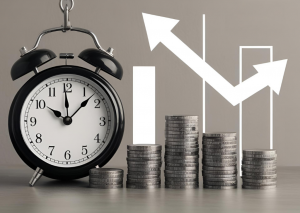Understanding Passive Income
The two main categories of income are active and passive. With active income, you trade time for money, and the amount of money you make directly correlates with the amount of time you work. Contrarily, passive income generates revenue unrelated to the number of hours worked and allows people to earn money without active participation. Passive investment is therefore among the most effective concepts for passive income.

What Are Dividends?
A dividend is a chunk of money a company gives its owners. A company’s shareholders get dividends, a percentage of its earnings, as an incentive for their investment. Although some companies offer a monthly dividend, they make the distributions infrequently, typically once a year or once every three months. You invest in dividend equities and receive regular payments as a result. Dividend stocks yield revenue on an ongoing quarterly or monthly basis. You can withdraw money from your brokerage account if you require the income.
Alternatively, you may reinvest the dividends to buy additional stock to increase your savings account. You may avoid missing out on potential by keeping an eye on earnings and reinvestments by using a dividend tracker. Diversification ensures that a single bad investment will not destroy your entire portfolio. Additionally, there is a decreased likelihood that troubles in a single sector will affect everything if there are multiple companies spread throughout numerous industries.
Types of Dividends and Importance of Choosing the Right Stocks
Note that, in addition to cash dividend payments, there are various other sorts of dividends, such as those from stocks and property dividends. Dividends are a great method of passive income since they need very little work to earn. As a result, investors frequently seek out dividend-paying companies to produce returns in addition to capital gains. Investors know this method as dividend investing.
Choosing companies with a track record of consistent dividend payments and sound financial standing is crucial for novices. Investors frequently find reputable dividend stocks in well-established sectors such as financial services, consumer goods, and utilities. Even in times of economic recession, these businesses are more inclined to carry on paying out.
Benefits of Dividend Strategies
Investors can profit from dividend approaches in an assortment of techniques, including compound growth, reduced volatility, inflation hedging, and consistent income. For retirees or those looking for passive income, these methods are suitable since they offer consistent cash flow. Growth assets are more volatile than dividend-paying equities, which established businesses often issue. Compound gains can result from reinvesting dividends since they purchase more shares, which accelerates growth by paying dividends. Investing in dividend stocks that continuously raise dividends helps investors fight inflation by ensuring that their income keeps pace with price increases. All things considered, both novice and experienced investors can benefit from dividend strategies.
REITs and Real Estate Investment Groups (REIGs)
Organizations that own, manage, or finance income-producing real estate, including farms, apartments, information technology centers, workplaces, industrial facilities, self-storage facilities, and more, are known as REITs. REITs are among the greatest options for passive income since they enable individual investors to receive dividends from real estate assets without having to own, manage, or finance any properties. Furthermore, unlike actual real estate investments, REITs offer very high liquidity because major stock markets list the majority of them.
Small rental property mutual funds operate similarly to real estate investment groups. If you want to own tangible real estate without the responsibility of being a landlord, this may be the ideal choice for you. A percentage of the rental revenue is distributed to the investors by REIGs, who also manage, maintain, and purchase properties. Those who want to engage in real estate but don’t have the time or skills to handle properties directly profit from this arrangement.
Cryptocurrency as a Passive Income Source
Cryptocurrencies have shown themselves to be a reliable tool for creating passive income. Long-term profits may be made just by keeping Bitcoin or other cryptocurrencies until their value soars. However, this applies both ways, as buying at the peak could lead your investment to devalue for years. Several financial products that replicate or even enhance already existing financial instruments have been created by the cryptocurrency sector. Undoubtedly, there are a ton of methods to use cryptocurrencies to generate passive income.
Risks of Dividend Growth Investing
A risky investment approach, dividend growth investing mostly depends on government interest rates and businesses’ capacity to conceal dividend payments. Investors may lose the money they have invested as a result, particularly if the government boosts the returns on its bonds. Retirement savings are hard to invest in typical dividend equities since they usually only yield an acceptable return for fifteen years or fewer. Corporations can use a variety of strategies to pay dividends, including income, debt acquisition, or fictitious cash flow.
It is challenging to purchase shares with fair dividends from a financially sound firm since these companies are more prevalent in the dividend growth market. The final concern associated with dividend stocks is the potential for corporations that pay dividends to alter their policies at any time, which might result in a sudden decline in stock prices and a loss of savings. Although this has happened before, businesses dislike this practice.

Value Investing vs. Dividend Growth Investing
Finding companies that have a low valuation on the market is the goal of value investing, a less hazardous option than dividend growth investment. This entails purchasing the stock at a fair price in the hopes that it will increase in value and provide profits for you later on.
Value investing has fewer factors to consider than dividend growth, but both need business study. It is a broader strategy for identifying a solid business that has gone through a difficult time and is anticipated to bounce back. Dividend growth investment, on the other hand, leaves greater leeway for mistakes by examining a company’s financial sources, reasons for success, and prospects for future success.
To sum everything up, investing in dividend growth is a hazardous approach that mostly depends on government interest rates and the ability to conceal dividend payments. Even if certain businesses pay dividends, buying in these equities requires extreme caution.





